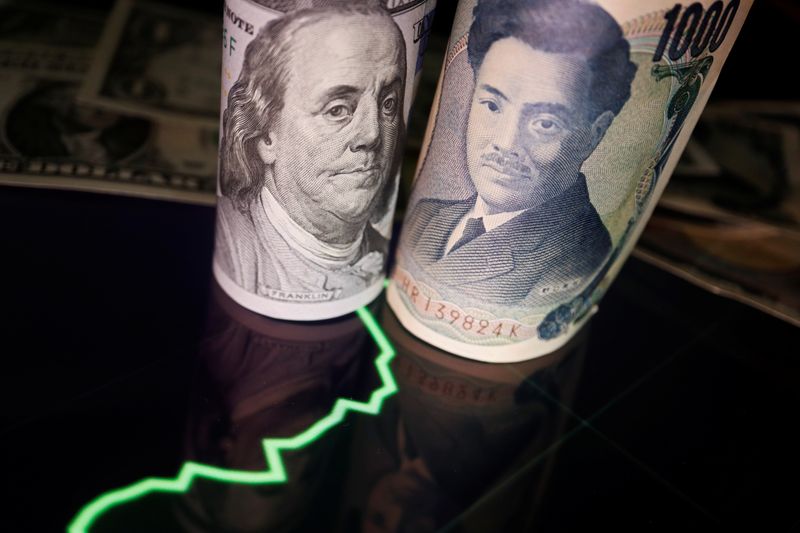Forex
Firm dollar adds pressure to sterling and euro

By Ankur Banerjee and Greta Rosen Fondahn
(Reuters) -The U.S. dollar drew strength from rising Treasury yields on Thursday, adding pressure to the pound and euro, while the yen edged up from recent lows, and the market waited for clarity on possible Trump tariffs.
The focus for markets in 2025 has been on U.S. President-elect Donald Trump’s agenda when he returns to the White House on Jan. 20, with analysts expecting his policies to both bolster growth and add to price pressures.
CNN on Wednesday reported that Trump was considering declaring a national economic emergency to provide legal justification for universal tariffs on allies and adversaries. On Monday, the Washington Post said Trump was looking at more nuanced tariffs, which he later denied.
Concerns that policies introduced by the Trump administration could reignite inflation has led bond yields higher, with the yield on the benchmark 10-year U.S. Treasury note hitting 4.73% on Wednesday, its highest since April 25. It was at 4.6628% on Thursday.[US/]
“Trump’s shifting narrative on tariffs has undoubtedly had an effect on USD. It seems this capriciousness is something markets will have to adapt to over the coming four years,” said Kieran Williams, head of Asia FX at InTouch Capital Markets.
The bond market sell-off has driven dollar strength, which is overshadowing other currencies.
Among the most affected was the pound. One of the best-performing currencies against the dollar in the last couple of years, it has fallen 1.9% over three days.
Sterling slid to $1.2239 on Thursday, its weakest since November 2023, even as British government bond yields hit multi-year highs. The pound was last down about 0.64% at $1.2285.
Ordinarily, higher gilt yields, meaning investors want a higher return for risk, would support the pound.
BRITISH GLOOM
As confidence in Britain’s fiscal outlook deteriorates, the sell-off in UK government bond markets resumed early on Thursday before a slight recovery that left 10-year and 30-year gilt yields around flat. [GBP/] [GB/]
“Such a simultaneous sell-off in currency and bonds is rather unusual for a G10 country,” said Michael Pfister, FX analyst at Commerzbank (ETR:).
“It seems to be the culmination of a development that began several months ago. The new Labour government’s approval ratings are at record lows just a few months after the election, and business and consumer sentiment is severely depressed.”
The euro also eased, albeit less than the pound, to $1.0298, close to the two-year low of $1.0224 it hit last week. Investors remain worried the single currency may fall to the psychological $1 mark this year due to tariff uncertainties.
A significant number of foreign exchange forecasters expect the euro to reach parity with the dollar in 2025, a Reuters poll showed on Wednesday.
The yen strengthened 0.39% on the day and was last at 157.72 per dollar, though it still hovered near the 160 per dollar mark that led Tokyo to intervene in the market last July.
It touched a near six-month low of 158.55 per dollar on Wednesday.
Japan’s inflation-adjusted real wages fell for the fourth straight month in November weighed down by higher prices, government data showed on Thursday.
That all left the , which measures the U.S. currency against six other units, up 0.13% at 109.16, just shy of the two-year high it touched last week.

Also in the mix were the Federal Reserve minutes of its December meeting, released on Wednesday, which showed the central bank flagged new inflation concerns and officials saw a rising risk the incoming administration’s plans may slow economic growth and raise unemployment.
With U.S. stock markets closed on Thursday, and U.S. bond markets closing early, the spotlight will be on Friday’s payrolls report as investors parse through data to gauge when the Fed will next cut rates.

 Forex3 years ago
Forex3 years agoForex Today: the dollar is gaining strength amid gloomy sentiment at the start of the Fed’s week

 Forex3 years ago
Forex3 years agoUnbiased review of Pocket Option broker

 Forex3 years ago
Forex3 years agoDollar to pound sterling exchange rate today: Pound plummeted to its lowest since 1985

 Forex3 years ago
Forex3 years agoHow is the Australian dollar doing today?

 Cryptocurrency3 years ago
Cryptocurrency3 years agoWhat happened in the crypto market – current events today

 World3 years ago
World3 years agoWhy are modern video games an art form?

 Commodities3 years ago
Commodities3 years agoCopper continues to fall in price on expectations of lower demand in China

 Economy3 years ago
Economy3 years agoCrude oil tankers double in price due to EU anti-Russian sanctions


























